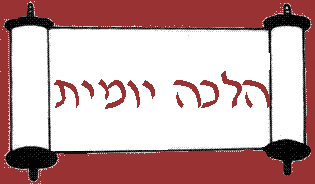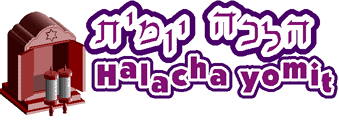
- Your questions
tefilah- Shmone Esrei l kashrut l tevilat keilim l brachot l lashon hara l matza guide
- Torah on the web-
links for kids
- Rabbanim
Mechanchim - Program Overview
- Samples
- Educational materials
 Frequently asked questions
Frequently asked questions
- Halacha Yomit topics
- More information
- How to order
- Order form
Parents - Review questions for the Shabbat
table
- Torah on the web-
links for parents
General - Participating schools
- Dedications
Kids



Questions About Parsha Primer
General Questions
-
Questions about Halacha Yomit
- What sources are used to prepare the halachot?
- Are various customs mentioned?
- What topics are covered in the program?
- How many years does it take to complete a full cycle of the material?
- Is the Halacha Yomit Program meant to be a complete halacha program, or is it meant to supplement a standard halacha curriculum?
- Is there any supplementary material that comes with the Halacha Yomit?
- How should we use the program?
- What ideas can we use to set up a halacha hidon (contest) based upon the material?
- What do the parsha sheets contain?
- How should we use the parsha sheets?
- Are the programs suitable for home schooling?
- When will the material arrive?
- Does Machon Halacha Yomit have any other educational materials for sale?
- I'm having trouble viewing the sample page, what should I do?
Questions about Parsha Primer
General Questions
QUESTIONS ABOUT HALACHA YOMIT
- What sources are used to prepare the halachot?

The halachot are based on many sources, ranging from the classical works of halacha through contemporary works, aiming to make the halachot pertinent to our students.
The source of any halacha not found in the Kitzur Shulchan Aruch (R' Shlomo Ganzfried zt"l) is cited in the footnotes.
Here is a partial list of the sources used in preparing the halachot:
Shulchan Aruch (and nosei keilim), Mishna Brura, Kaf Hachaim, Chayei Adam, Ben Ish Chai, Shulchan Aruch Harav, Maase Rav, Aruch Hashulchan, Sefer Hatodaah, Shmirat Shabbat K'hilchata, Shearim Metzuyanim Bahalacha, Kitzur Shulchan Aruch Mekor Chaim, Yalkut Yosef, Pitchei Choshen, V'zot Habracha, Igrot Moshe, Kitvei Hagaon R' Yosef Eliyahu Henkin zt"l, Yabia Omer, Yechave Daat, Hakashrut K'halacha.
All the halachot in the regular program and on the web-site are reviewed by another rabbi.
